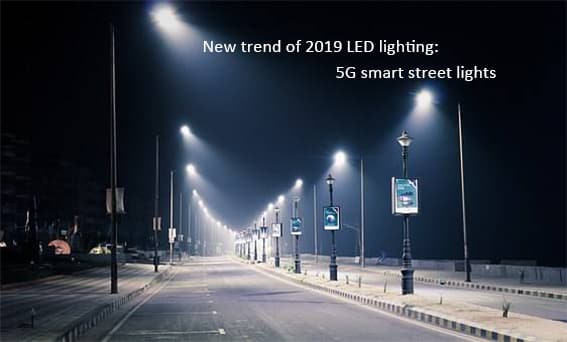Starting from 2018, the topic of 5G related technology manufacturing keeps on going, and people from all walks of life begin to discuss how the demand of 5G will improve the economic effect of relevant industrial supply chain.
International standards organization 3GPP unveiled the first 5G standard in June, which will provide high-speed, reliable and low-latency wireless communication technology. 2019 is also known as “the first year of 5G”. The Internet of things (IoT) devices have entered 5G generation applications in the face of new technologies.
According to Electronics 360, as more streetlights and commercial infrastructure become smart LED lighting, emerging technologies are integrating other smart city and lighting applications. The new intelligent lighting has been equipped with the Internet of things connection function, and each LED lighting device has its own IP location.
According to IHS Markit, a market research firm, smart lighting in business applications continues to grow, and with an estimated $21 billion in business opportunities by 2022, up from $7.2 billion in 2018 and a compound annual growth rate (CAGR) of 21%.
In the future, with the emergence of 5G technology, it can reach the Gigabit transmission rate per second, and greatly reduce the delay phenomenon. The market is also gradually expanding for ultra-reliable low-latency communication (URLLC) service, which can promote the transportation transformation, including self-driving technology, road safety and public transportation service system.
However, due to the penetration of 5G signals, it is easy to block the transmission range and generate dead space. Therefore, more base stations are needed in cities to increase the coverage rate of 5G networks. In view of this, many network operators are looking for smart street lamps as a solution to layout the city 5G base.
Smart street lighting is a key project in the development of smart cities. This technology can not only reduce management costs, but also provide Shared power or self-driving applications.
Wang Shen, senior analyst at IHS Markit, said that China has been developing smart street lights. The advantages of 5G base stations carrying street lights include Shared power supply, which helps reduce wiring costs, while base stations will have a higher installation density, ensuring that they can cover all corners of the city.
Currently, smart street lamps in most areas have tiny 4G LTE base stations capable of handling huge information traffic demands, and the same model will be applicable to 5G networks in the future.
In the future, 5G base station can be used as an auxiliary application of intelligent traffic, which can immediately convey traffic warning to drivers and provide emergency evacuation instructions through flashing lights. Smart street lights can also realize hot spot support or cloud-based autopilot functions.
In addition, with the increasing influence of energy conservation and environmental protection awareness, 5G smart lighting devices can adjust brightness at any time to save energy and life. Although the current infrastructure and network construction cannot be completed smoothly in 2019, 5G smart street lamps will be put into use in the near future.
In addition to 5G smart street lamps, another trend of LED lighting in 2019 is to integrate smart home devices into entertainment, security monitoring and voice control products. In addition, smart lighting systems that connect IoT Platforms, collect user information and process networked lighting devices, are expected to drive the technology industry chain.





